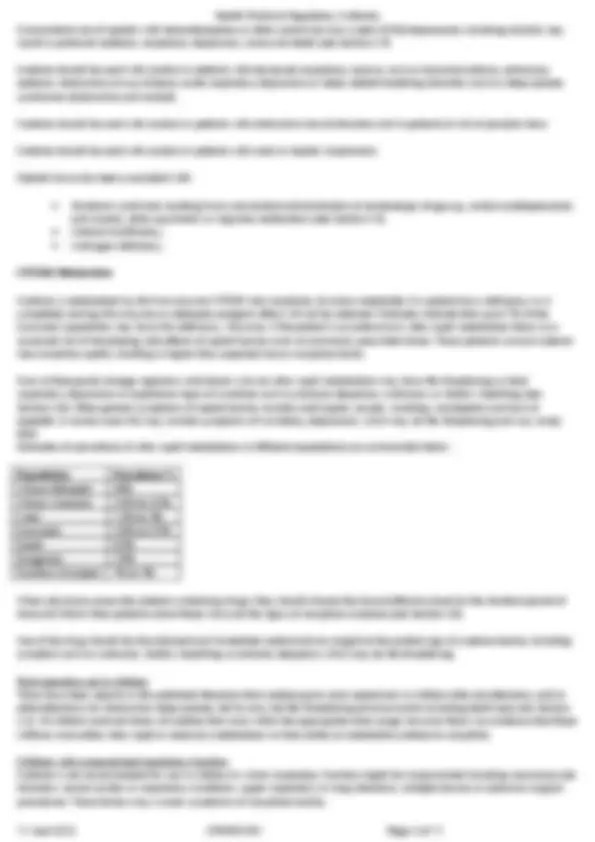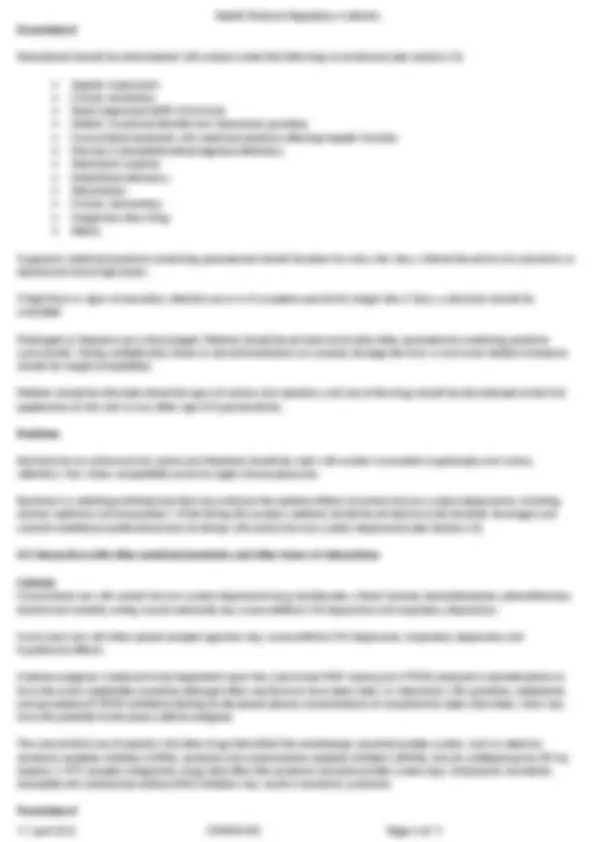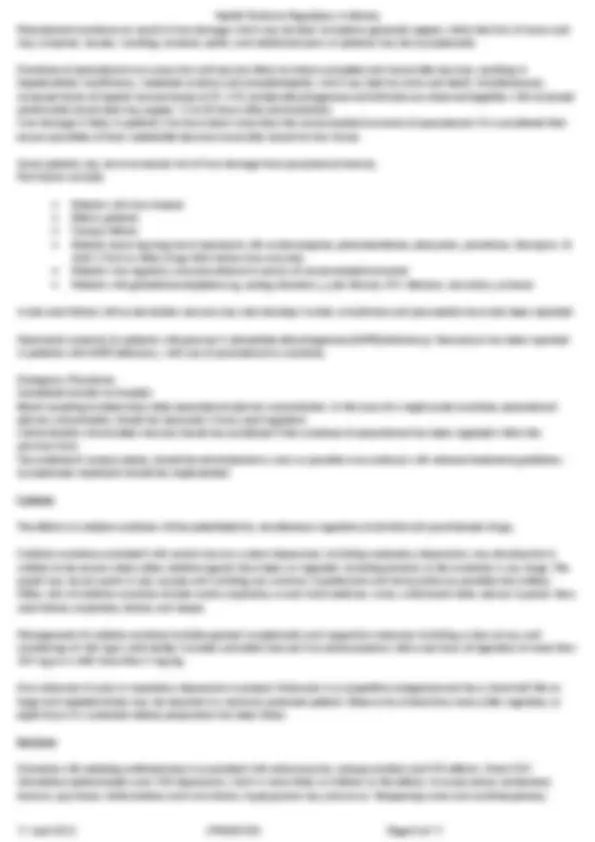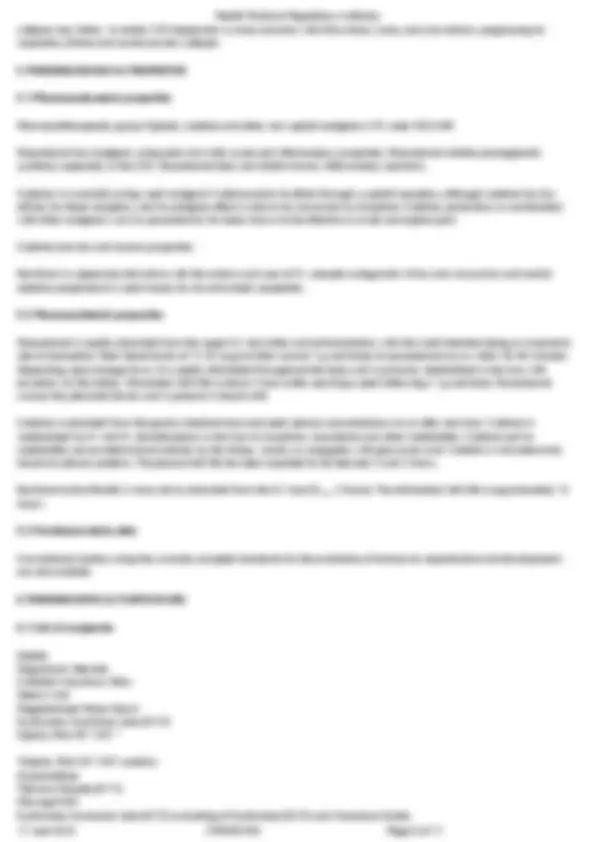








Study with the several resources on Docsity

Earn points by helping other students or get them with a premium plan


Prepare for your exams
Study with the several resources on Docsity

Earn points to download
Earn points by helping other students or get them with a premium plan
Community
Ask the community for help and clear up your study doubts
Discover the best universities in your country according to Docsity users
Free resources
Download our free guides on studying techniques, anxiety management strategies, and thesis advice from Docsity tutors
Information on the use of Codeine and Paracetamol for pain relief, with warnings for specific populations and interactions with other medications. It also includes a list of adverse reactions and contraindications.
Typology: Exams
1 / 11

This page cannot be seen from the preview
Don't miss anything!







Migraleve Pink Film-coated Tablets Paracetamol 500mg Codeine Phosphate 8mg Buclizine Hydrochloride 6.25mg 2 QUALITATIVE AND QUANTITATIVE COMPOSITION Each Migraleve Pink tablet contains: Paracetamol 500 mg (as Paracetamol DC 96%), Codeine phosphate 8 mg, Buclizine hydrochloride 6.25 mg. For a full list of excipients, see section 6.1. 3 PHARMACEUTICAL FORM Film-coated tablet. (Tablet) Pink film-coated capsule-shaped tablets engraved ‘MGE’ on one face. 4 CLINICAL PARTICULARS 4.1 Therapeutic Indications For the prevention and treatment of migraine attacks which can include the symptoms of migraine headache, nausea and vomiting. Route of administration: oral. Codeine is indicated in patients older than 12 years of age for the treatment of acute moderate pain which is not considered to be relieved by other analgesics such as paracetamol or ibuprofen (alone). 4.2 Posology and method of administration Do not take for more than 3 days continuously without medical review. If prescribed do not take for longer than directed. Codeine-containing products should be used at the lowest effective dose for the shortest period of time. Adults and the elderly: One to two Migraleve Pink tablets to be swallowed immediately it is known that a migraine attack has started or is imminent. If further treatment is required, one to two Migraleve Yellow tablets every 4-6 hours. Maximum dose: 8 tablets (two Migraleve Pink and six Migraleve Yellow) in 24 hours. Paediatric population: Children aged 16 – 18 years: One to two Migraleve Pink tablets to be swallowed immediately it is known that a migraine attack has started or is imminent. If further treatment is required, one to two Migraleve Yellow tablets every 6 hours. Maximum dose: 8 tablets (two Migraleve Pink and six Migraleve Yellow) in 24 hours. Children 12 – 15 years: One Migraleve Pink tablet to be swallowed immediately it is known that a migraine attack has started or is imminent. If further treatment is required, one Migraleve Yellow tablet every 6 hours. Maximum dose: 4 tablets (one Migraleve Pink and three Migraleve Yellow) in 24 hours. Children aged below 12 years: Do not give to children under 12 years because of the risk of opioid toxicity due to the variable and unpredictable metabolism of codeine to morphine (see Section 4.3 and Section 4.4). Paracetamol Warnings: Renal impairment:
It is recommended, when giving paracetamol to patients with renal impairment, to reduce the dose and to increase the minimum interval between each administration to at least 6 hours unless directed otherwise by a physician. See Table below: Adults: Glomerular filtration rate Dose 10-50 ml/min 500mg every 6 hours <10ml/min 500mg every 8 hours Hepatic impairment: In patients with hepatic impairment or Gilbert's Syndrome, the dose should be reduced or the dosing interval prolonged. The daily dose should not exceed 2g/day unless directed by a physician. The Elderly: Experience has indicated that normal adult dosage is usually appropriate. However in frail, immobile, elderly subjects or in elderly patients with renal or hepatic impairment, a reduction in the amount or frequency of dosing may be appropriate. The maximum daily dose should not exceed 60mg/kg/day (up to a maximum of 2g per day) in the following situations, unless directed by a physician: Weight less than 50kg Chronic alcoholism Dehydration Chronic malnutrition 4.3 Contraindications Hypersensitivity to the active substances (Paracetamol, Codeine phosphate and /or Buclizine hydrochloride) or to any of the excipients listed in section 6.1. Codeine-containing products are contraindicated for postoperative pain management in all paediatric patients (0-18 years of age) who have undergone tonsillectomy and/or adenoidectomy for obstructive sleep apnoea syndrome due to an increased risk of developing serious and life-threatening adverse reactions (see Section 4.4). In women during breastfeeding (see Section 4.6). In patients for whom it is known they are CYP2D6 ultra-rapid metabolisers. Migraleve tablets are contraindicated for children below 12 years of age. 4.4 Special warnings and precautions for use Migraine should be medically diagnosed. Because some medicines do not combine, patients should be advised to tell their doctor if they are already taking prescribed medicines. They should also be advised to consult their doctor if symptoms persist. Migraleve tablets are intended for short-term use only. Migraleve tablets contain potent medicaments and should not be taken continuously for extended periods without the advice of a doctor. Do not exceed the stated dose. Codeine Codeine is an opioid agent. Tolerance, psychological and/or physical dependence may occur with prolonged use and/or high doses of codeine (see Section 4.8). Prolonged regular use for more than 3 days, except under medical supervision, may lead to physical and psychological dependence (addiction) and result in withdrawal symptoms, such as restlessness and irritability once the drug is stopped. Opioid-induced hyperalgesia has been reported with longer term treatment or withdrawal from opioids, particularly at high doses. Codeine should be used with caution in patients with convulsive disorders, head injuries, and in conditions in which intracranial pressure is raised.
Paracetamol Paracetamol should be administered with caution under the following circumstances (see section 4.2): Hepatic impairment Chronic alcoholism Renal impairment (GFR≤50ml/min) Gilbert's Syndrome (familial non-haemolytic jaundice) Concomitant treatment with medicinal products affecting hepatic function Glucose-6-phosphate dehydrogenase deficiency Haemolytic anaemia Glutathione deficiency Dehydration Chronic malnutrition Weight less than 50kg Elderly In general, medicinal products containing paracetamol should be taken for only a few days without the advice of a physician or dentist and not at high doses. If high fever or signs of secondary infection occur or if symptoms persist for longer than 3 days, a physician should be consulted. Prolonged or frequent use is discouraged. Patients should be advised not to take other paracetamol-containing products concurrently. Taking multiple daily doses in one administration can severely damage the liver; in such case medical assistance should be sought immediately. Patients should be informed about the signs of serious skin reactions, and use of the drug should be discontinued at the first appearance of skin rash or any other sign of hypersensitivity. Buclizine Buclizine has an antimuscarinic action and therefore should be used with caution in prostatic hypertrophy and urinary retention. Also where susceptibility exists to angle-closure glaucoma. Buclizine is a sedating antihistamine that may enhance the sedative effects of central nervous system depressants, including alcohol, sedatives and tranquilizers. While taking this product, patients should be advised to avoid alcoholic beverages and consult a healthcare professional prior to taking with central nervous system depressants (see Section 4.5). 4.5 Interaction with other medicinal products and other forms of interactions Codeine Concomitant use with central nervous system depressants (e.g. barbiturates, chloral hydrate, benzodiazepines, phenothiazines, alcohol and centrally acting muscle relaxants) may cause additive CNS depression and respiratory depression. Concurrent use with other opioid receptor agonists may cause additive CNS depression, respiratory depression and hypotensive effects. Codeine analgesia is believed to be dependent upon the cytochrome P450 isoenzyme CYP2D6 catalysed o-demethylation to form the active metabolite morphine although other mechanisms have been cited. An interaction with quinidine, methadone and paroxetine (CYP2D6 inhibitors) leading to decreased plasma concentrations of morphine has been described, which may have the potential to decrease codeine analgesia. The concomitant use of opioids with other drugs that affect the serotonergic neurotransmitter system, such as selective serotonin reuptake inhibitors (SSRIs), serotonin and noradrenaline reuptake inhibitors (SNRIs), tricyclic antidepressants (TCAs), triptans, 5-HT3 receptor antagonists, drugs that affect the serotonin neurotransmitter system (e.g. mirtazapine, trazodone, tramadol) and monoamine oxidase (MA) inhibitors may result in serotonin syndrome. Paracetamol
The use of drugs which induce hepatic microsomal enzymes, such as anticonvulsants and oral contraceptive steroids, may increase the extent of metabolism of paracetamol, resulting in reduced plasma concentrations of the drug and a faster elimination rate. The speed of absorption of paracetamol may be increased by metoclopramide or domperidone and absorption reduced by cholestyramine. The anticoagulant effect of warfarin and other coumarins may be enhanced by prolonged regular use of paracetamol with increased risk of bleeding; occasional doses have no significant effect. Chronic alcohol intake may increase the hepatotoxicity of paracetamol overdose and may have contributed to the acute pancreatitis reported in one patient who had taken an overdose of paracetamol. Acute alcohol intake may diminish an individual's ability to metabolise large doses of paracetamol, the plasma half-life of which can be prolonged. High anion gap metabolic acidosis from pyroglutamic acid (5-oxoprolinemia) has been reported with concomitant use of therapeutic doses of paracetamol and flucloxacillin. Patients reported to be most at risk are elderly females with underlying disease such as sepsis, renal function abnormality, and malnutrition. Most patients improve after stopping one or both of the drugs. Consumers should be instructed to ask their health care provider before use if they are taking the antibiotic flucloxacillin. Buclizine Sedating antihistamines, such as buclizine, have an additive effect with alcohol and other CNS depressants, Sedating antihistamines have an added antimuscarinic action with other antimuscarinic drugs such as atropine and some antidepressants (both tricyclic and MAOIs). 4.6 Fertility, pregnancy and lactation Pregnancy This product should not be used during pregnancy unless the potential benefit of treatment to the mother outweighs the possible risks to the developing foetus. Codeine crosses the placenta. Neonates who have been exposed to codeine in utero can develop withdrawal syndrome (neonatal abstinence syndrome) after delivery. Cerebral infarction has been reported in this setting. A large amount of data on pregnant women indicate neither malformative, nor feto/neonatal toxicity. Epidemiological studies on neurodevelopment in children exposed to paracetamol in utero show inconclusive results. If clinically needed, paracetamol can be used during pregnancy however it should be used at the lowest effective dose for the shortest possible time and at the lowest possible frequency. When given to the mother in labelled doses, paracetamol crosses the placenta into foetal circulation as early as 30 minutes after ingestion and is effectively metabolised by foetal sulfate conjugation. Clinical data with use of buclizine in humans are not adequate to establish safety during pregnancy. Although experiments in some animal species gave rise to adverse effects following the administration of buclizine to pregnant animals e.g. foetal abnormalities and maternal deaths, these occurred at doses in excess of 120 times the human daily dose. Breastfeeding Codeine is contraindicated in breastfeeding women (see Section 4.3). At normal therapeutic doses, codeine and its active metabolites may be present in breast milk at very low concentrations and are unlikely to adversely affect the breast fed infant. However if the patient is an ultra-rapid metaboliser of CYP2D6, higher levels of the active metabolite, morphine, may be present in breast milk and on very rare occasions may result in symptoms of opioid toxicity in the infant which may be fatal.
Not known Dyspnoea^6 Not known Respiratory depression^2 Gastrointestinal disorders Very common Nausea1, Common Constipation1, Common Dry mouth^1 Common Vomiting1, Uncommon Abdominal pain^6 Uncommon Dyspepsia^2 Hepatobiliary disorders Not known Liver injury^3 Skin and subcutaneous tissue disorders Common Hyperhidrosis^1 Uncommon Pruritus3, Uncommon Rash^3 Uncommon Urticaria2, Not known Angioedema^6 Not known Dermatitis^2 Not known Fixed eruption^3 Renal and urinary disorders Uncommon Nephropathy toxic^3 Investigations Not known Transaminases increased^7 (^1) Adverse events reported by ≥1% of codeine/paracetamol treated subjects in 27 randomised placebo-controlled trials (^2) Associated with codeine (^3) Associated with paracetamol (^4) Reported following paracetamol use, but not necessarily causally related to the drug (^5) Associated with buclizine (^6) Associated with paracetamol / codeine combination (^7) Low level transaminase elevations may occur in some patients taking therapeutic doses of paracetamol; these elevations are not accompanied with liver failure and usually resolve with continued therapy or discontinuation of paracetamol. Other adverse reactions (codeine class effects) include: Sedation Vertigo Bronchospasm Gastrointestinal disorder, such as dyspepsia, nausea, vomiting, constipation Euphoric mood Drug dependence can develop following long-term use of high doses Reporting of suspected adverse reactions Reporting suspected adverse reactions after authorisation of the medicinal product is important. It allows continued monitoring of the benefit/risk balance of the medicinal product. Healthcare professionals are asked to report any suspected adverse reactions via HPRA Pharmacovigilance, website: www.hpra.ie. 4.9 Overdose Paracetamol
Paracetamol overdose can result in liver damage which may be fatal. Symptoms generally appear within the first 24 hours and may comprise: nausea, vomiting, anorexia, pallor, and abdominal pain, or patients may be asymptomatic. Overdose of paracetamol can cause liver cell necrosis likely to induce complete and irreversible necrosis, resulting in hepatocellular insufficiency, metabolic acidosis and encephalopathy which may lead to coma and death. Simultaneously, increased levels of hepatic transaminases (AST, ALT), lactate dehydrogenase and bilirubin are observed together with increased prothrombin levels that may appear 12 to 48 hours after administration. Liver damage is likely in patients who have taken more than the recommended amounts of paracetamol. It is considered that excess quantities of toxic metabolite become irreversibly bound to liver tissue. Some patients may be at increased risk of liver damage from paracetamol toxicity. Risk factors include: Patients with liver disease Elderly patients Young children Patients receiving long-term treatment with carbamazepine, phenobarbitone, phenytoin, primidone, rifampicin, St John's Wort or other drugs that induce liver enzymes. Patients who regularly consume ethanol in excess of recommended amounts Patients with glutathione depletion e.g. eating disorders, cystic fibrosis, HIV infection, starvation, cachexia Acute renal failure with acute tubular necrosis may also develop. Cardiac arrhythmias and pancreatitis have also been reported. Haemolytic anaemia (in patients with glucose-6-phosphate dehydrogenase [G6PD] deficiency): Haemolysis has been reported in patients with G6PD deficiency, with use of paracetamol in overdose. Emergency Procedure: Immediate transfer to hospital. Blood sampling to determine initial paracetamol plasma concentration. In the case of a single acute overdose, paracetamol plasma concentration should be measured 4 hours post ingestion. Administration of activated charcoal should be considered if the overdose of paracetamol has been ingested within the previous hour. The antidote N-acetylcysteine, should be administered as soon as possible in accordance with national treatment guidelines. Symptomatic treatment should be implemented. Codeine The effects in codeine overdose will be potentiated by simultaneous ingestion of alcohol and psychotropic drugs. Codeine overdose associated with central nervous system depression, including respiratory depression, may develop but is unlikely to be severe unless other sedative agents have been co-ingested, including alcohol, or the overdose is very large. The pupils may be pin-point in size; nausea and vomiting are common. Hypotension and tachycardia are possible but unlikely. Other risks of codeine overdose include cardio-respiratory arrest, brain oedema, coma, confusional state, seizure, hypoxia, ileus, renal failure, respiratory failure, and stupor. Management of codeine overdose includes general symptomatic and supportive measures including a clear airway and monitoring of vital signs until stable. Consider activated charcoal if an adult presents within one hour of ingestion of more than 350 mg or a child more than 5 mg/kg. Give naloxone if coma or respiratory depression is present. Naloxone is a competitive antagonist and has a short half-life so large and repeated doses may be required in a seriously poisoned patient. Observe for at least four hours after ingestion, or eight hours if a sustained release preparation has been taken. Buclizine Overdose with sedating antihistamines is associated with antimuscarinic, extrapyramidal, and CNS effects. When CNS stimulation predominates over CNS depression, which is more likely in children or the elderly, it causes ataxia, excitement, tremors, psychoses, hallucinations and convulsions; hyperpyrexia may also occur. Deepening coma and cardiorespiratory
6.2 Incompatibilities Not applicable.
6.3 Shelf life 3 years. 6.4 Special precautions for storage Do not store above 30°C. 6.5 Nature and contents of container Clear amber PVC/Aluminium foil blisters or clear amber PVC/Laminated paper and aluminium foil child resistant blisters Packs of 12, 24 and 48 tablets. Not all pack sizes may be marketed. 6.6 Special precautions for disposal No special requirements for disposal. Any unused medicinal product or waste material should be disposed of in accordance with local requirements. 7 MARKETING AUTHORISATION HOLDER Johnson & Johnson (Ireland) Limited Airton Road Tallaght Dublin 24 Ireland 8 MARKETING AUTHORISATION NUMBER PA0330/030/ 9 DATE OF FIRST AUTHORISATION/RENEWAL OF THE AUTHORISATION Date of first authorisation: 01 April 1978 Date of last renewal: 01 April 2008 10 DATE OF REVISION OF THE TEXT April 2022